Vicenza History and Heritage - A medieval landscape of fortified walls and towers, shaped, with classical precepts, by the genius of Palladio and the prosperity of Venice
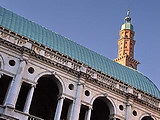 Once known as the Venice of the Mainland, Vicenza's age-old ties with Venice are the most immediate key to interpreting the resplendent beauty of its neoclassical buildings and country villas. The importance of the navigable waterways that linked Venice with inland towns, as well as many country villas, is paramount in any effort to imagine the period that produced such splendour, and should be borne in mind when visiting the sites. For example, though now a public square, Vicenza’s Piazza Mateotti, the site of the exquisite Palladian Palazzo Chiericati, was in fact used as a waterway and a direct route to the nearby Retrone river.
Once known as the Venice of the Mainland, Vicenza's age-old ties with Venice are the most immediate key to interpreting the resplendent beauty of its neoclassical buildings and country villas. The importance of the navigable waterways that linked Venice with inland towns, as well as many country villas, is paramount in any effort to imagine the period that produced such splendour, and should be borne in mind when visiting the sites. For example, though now a public square, Vicenza’s Piazza Mateotti, the site of the exquisite Palladian Palazzo Chiericati, was in fact used as a waterway and a direct route to the nearby Retrone river.
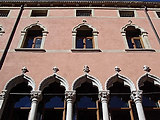 In the countryside the villa usually served, not merely as a retreat, but as the centre of the estate’s agricultural production, and, in town, a patrician or merchant’s residence was designed to allow him to comfortably conduct his affairs while affirming his status in the community. Goods were placed on barges and were said to reach Venice in as little as twelve hours.
In the countryside the villa usually served, not merely as a retreat, but as the centre of the estate’s agricultural production, and, in town, a patrician or merchant’s residence was designed to allow him to comfortably conduct his affairs while affirming his status in the community. Goods were placed on barges and were said to reach Venice in as little as twelve hours.
Civic pride and values just as now were embodied in the public administration buildings, with the magnificent churches taking care of the spiritual dimension. A simple and familiar pattern that is useful in our approach not just to Vicenza, but to the whole of the Veneto, the heartland of the old Venetian republic into which Vicenza was incorporated in 1404.
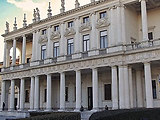 Those with an appreciation of Venice's architectural gems will be already familiar with the great architect Andrea Palladio, the town's most illustrious citizen and the man whose lasting legacy was to leave his mark on Vicenza more than any other place. But behind the classical harmony of the great Palladian buildings you will also find a more ancient Vicenza, that harks back to the days of a less established social order and the daily strife and power struggles between rival families, well known to Shakespeare’s audience. Indeed if you dart down some of the smaller streets you may still come across some of the tall bulky houses with their defensive turrets, each bearing the family’s coat of arms, and built to enforce their ancestral rights but in many cases to defend their lives.
Those with an appreciation of Venice's architectural gems will be already familiar with the great architect Andrea Palladio, the town's most illustrious citizen and the man whose lasting legacy was to leave his mark on Vicenza more than any other place. But behind the classical harmony of the great Palladian buildings you will also find a more ancient Vicenza, that harks back to the days of a less established social order and the daily strife and power struggles between rival families, well known to Shakespeare’s audience. Indeed if you dart down some of the smaller streets you may still come across some of the tall bulky houses with their defensive turrets, each bearing the family’s coat of arms, and built to enforce their ancestral rights but in many cases to defend their lives.
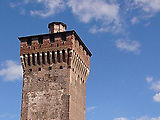
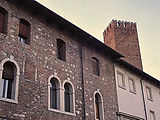 In fact, if perhaps outclassed in elegance by the villas, it is just such wonderfully massive medieval structures: castles towers and walls, many perfectly intact or restored, and within easy reach, that provide the dominant flavour for most of the outlying province, so evocative of the period and so enjoyable to explore. The picturesque town of Bassano is overlooked by Ezzelino’s imposing castle and walls, the hill town of Marostica has both an upper and lower castle; the lower one is famously the venue of the original human chess game, now re-enacted in style every two years, in full costume, complete with pomp and pageantry. As an alternative to the more usual method of a duel or jousting tournament, the original chess match of 1454 was devised to settle a feud between two rival families both fielding suitors for the hand of a local maiden.
In fact, if perhaps outclassed in elegance by the villas, it is just such wonderfully massive medieval structures: castles towers and walls, many perfectly intact or restored, and within easy reach, that provide the dominant flavour for most of the outlying province, so evocative of the period and so enjoyable to explore. The picturesque town of Bassano is overlooked by Ezzelino’s imposing castle and walls, the hill town of Marostica has both an upper and lower castle; the lower one is famously the venue of the original human chess game, now re-enacted in style every two years, in full costume, complete with pomp and pageantry. As an alternative to the more usual method of a duel or jousting tournament, the original chess match of 1454 was devised to settle a feud between two rival families both fielding suitors for the hand of a local maiden.
Also in the province of Vicenza, and within easy reach, are the castles of two even more renowned rival families: Indeed, the less attentive of the immortal bard's followers will content themselves with Venice or Verona, but the more curious will be on a pilgrimage to the town of Montecchio Maggiore, and the remains of the hilltop fortresses belonging to the Montecchi (Montagues) and Capuletti (Capulets), the legendary protagonists of the Romeo and Juliet saga.

 Cecilia Masaracchia is Tour-Vicenza's main guide, she has over ten years experience in the field and is an Official Tour Guide for Vicenza and the Veneto Villas, selected and accredited by the provincial authorities.
Cecilia Masaracchia is Tour-Vicenza's main guide, she has over ten years experience in the field and is an Official Tour Guide for Vicenza and the Veneto Villas, selected and accredited by the provincial authorities.